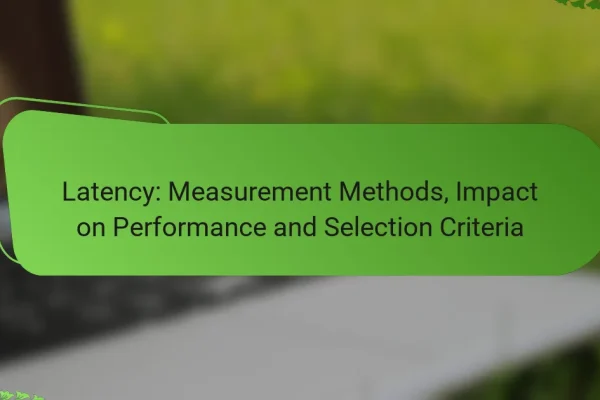What are the key proxy performance metrics?
The key proxy performance metrics include latency, throughput, uptime, error rate, and connection speed. These metrics help assess the efficiency and reliability of proxy servers, guiding users in selecting the best options for their needs.
Latency
Latency measures the time it takes for a request to travel from the client to the proxy server and back. Lower latency is crucial for real-time applications, where delays can disrupt user experience. Aim for latency in the low tens of milliseconds for optimal performance.
To reduce latency, consider the geographical location of the proxy server relative to your users. Using a proxy closer to your target audience can significantly decrease response times.
Throughput
Throughput refers to the amount of data processed by the proxy server in a given time frame, typically measured in megabits per second (Mbps). Higher throughput indicates better performance, especially for data-intensive applications. Aim for throughput that meets your application’s requirements without bottlenecks.
When selecting a proxy, evaluate its bandwidth limits and ensure they align with your expected usage. For instance, a proxy with a throughput of 100 Mbps may suffice for standard browsing, while streaming services may require higher rates.
Uptime
Uptime is the percentage of time a proxy server is operational and accessible. A high uptime percentage, ideally above 99%, ensures that users can consistently connect without interruptions. Regular monitoring can help identify potential downtime issues.
Choose proxy providers that offer service level agreements (SLAs) guaranteeing uptime. This can provide peace of mind and help you avoid disruptions in service.
Error rate
Error rate measures the frequency of failed requests processed by the proxy server. A low error rate indicates reliable performance, while a high error rate can lead to frustration and inefficiencies. Aim for an error rate below 1% for optimal user experience.
To minimize error rates, ensure your proxy server is properly configured and maintained. Regular updates and monitoring can help identify and resolve issues before they impact users.
Connection speed
Connection speed refers to how quickly a proxy server establishes a connection with the client. Faster connection speeds enhance user experience, especially for applications requiring quick access. Look for connection speeds in the range of a few hundred milliseconds for best results.
When evaluating proxies, test connection speeds during peak usage times to get a realistic view of performance. This can help you choose a proxy that meets your needs during high-demand periods.
How do proxy performance metrics impact user experience?
Proxy performance metrics significantly influence user experience by determining how quickly and reliably content is delivered. High-performance proxies can reduce delays, enhance reliability, and improve security, leading to a smoother interaction for users.
Reduced loading times
Reduced loading times are crucial for maintaining user engagement. Proxies that cache content can serve data faster, minimizing the time users wait for pages to load. For instance, a well-optimized proxy can decrease loading times to low tens of milliseconds, enhancing overall satisfaction.
To achieve optimal loading times, choose proxies with low latency and high bandwidth. Regularly monitor performance metrics to identify any bottlenecks that may arise, ensuring that users experience swift access to content.
Improved reliability
Improved reliability ensures that users can access content consistently without interruptions. Proxies can distribute traffic evenly across multiple servers, reducing the likelihood of downtime during peak usage. This can be particularly important for businesses that rely on constant availability.
To enhance reliability, select proxies that offer failover options and load balancing. Regularly test the proxy’s performance under various conditions to ensure it can handle unexpected spikes in traffic without compromising user experience.
Enhanced security
Enhanced security is a vital aspect of proxy performance metrics, as it protects user data and privacy. Proxies can encrypt data transmissions, making it more difficult for malicious actors to intercept sensitive information. This is especially important for online transactions and personal data exchanges.
When choosing a proxy, look for features such as SSL encryption and DDoS protection. Regularly update security protocols and conduct vulnerability assessments to safeguard user information and maintain trust in your services.
What tools can measure proxy performance metrics?
Several tools can effectively measure proxy performance metrics, providing insights into speed, reliability, and overall efficiency. These tools help users monitor response times, uptime, and other critical factors that influence the performance of proxy servers.
Pingdom
Pingdom is a widely used monitoring tool that offers real-time insights into website performance, including proxy metrics. It provides detailed reports on response times, uptime, and transaction monitoring, allowing users to identify potential bottlenecks.
With Pingdom, users can set up alerts to notify them of any performance issues, helping to ensure that proxies are functioning optimally. The tool is user-friendly and offers a variety of pricing plans, making it accessible for both small businesses and larger enterprises.
New Relic
New Relic is a comprehensive performance monitoring solution that tracks application performance, including proxy servers. It provides deep insights into response times, error rates, and throughput, enabling users to pinpoint issues quickly.
This tool offers advanced analytics and visualization features, making it easier to understand complex data. New Relic’s pricing is based on usage, which can be beneficial for organizations looking to scale their monitoring efforts as needed.
Datadog
Datadog is a cloud-based monitoring service that provides extensive visibility into proxy performance metrics. It integrates with various systems and applications, allowing users to track metrics across their entire infrastructure.
Datadog offers customizable dashboards and alerts, making it easy to monitor performance in real-time. Its pricing model is based on the number of hosts monitored, which can be cost-effective for businesses managing multiple proxies.
How to optimize proxy performance metrics?
To optimize proxy performance metrics, focus on load balancing, regular monitoring, and configuration tuning. These strategies help ensure efficient data flow, minimize latency, and enhance overall system reliability.
Load balancing
Load balancing distributes incoming traffic across multiple proxy servers to prevent any single server from becoming a bottleneck. This can significantly improve response times and reduce downtime. Consider using round-robin or least connections methods for effective load distribution.
Implementing a load balancer can also provide redundancy; if one server fails, others can take over without service interruption. Aim for a setup that can handle peak loads, typically by provisioning servers for at least 150% of expected maximum traffic.
Regular monitoring
Regular monitoring of proxy performance metrics is crucial for identifying issues before they impact users. Use tools that track latency, throughput, and error rates to gain insights into your proxy’s performance. Set up alerts for unusual spikes or drops in these metrics.
Establish a routine for reviewing logs and metrics, ideally daily or weekly, depending on your traffic volume. This proactive approach allows for timely adjustments and ensures that your proxy infrastructure remains efficient and responsive.
Configuration tuning
Configuration tuning involves adjusting settings to optimize the performance of your proxy servers. Key parameters to consider include timeout settings, buffer sizes, and connection limits. Fine-tuning these can lead to significant performance improvements.
Test different configurations in a controlled environment before applying them to production. Monitor the impact of changes on performance metrics to determine the most effective settings. Avoid making too many changes at once, as this can complicate troubleshooting if issues arise.
What are the common challenges in measuring proxy performance?
Measuring proxy performance can be complicated due to various factors that affect accuracy and reliability. Key challenges include network variability, data accuracy, and resource limitations, each of which can significantly impact performance metrics.
Network variability
Network variability refers to the fluctuations in connection quality and speed that can occur due to changes in traffic, server load, or geographic distance. These variations can lead to inconsistent performance metrics, making it difficult to assess the true efficiency of a proxy.
To mitigate network variability, consider conducting tests at different times of day and under varying conditions. This approach helps to establish a more comprehensive understanding of performance across diverse scenarios.
Data accuracy
Data accuracy is crucial for reliable proxy performance measurement. Inaccurate data can arise from faulty measurement tools, improper configurations, or external factors affecting the data collection process.
To ensure data accuracy, use standardized testing methods and reliable tools. Regularly calibrate your measurement equipment and validate results against known benchmarks to maintain integrity in your performance assessments.
Resource limitations
Resource limitations can hinder the ability to conduct thorough performance evaluations. Constraints may include insufficient bandwidth, limited access to testing tools, or inadequate hardware to run tests effectively.
To address resource limitations, prioritize essential tests that provide the most valuable insights. Consider using cloud-based testing services that can offer scalable resources without significant upfront investment.
What are the best practices for reporting proxy performance metrics?
Best practices for reporting proxy performance metrics include consistent data collection, clear visualization, and regular analysis. These practices help stakeholders understand the effectiveness and efficiency of proxy services, enabling informed decisions.
Define key performance indicators (KPIs)
Identifying relevant key performance indicators (KPIs) is essential for effective proxy performance reporting. Common KPIs include response time, uptime, and error rates. These metrics provide a clear picture of how well the proxy is functioning.
When defining KPIs, consider the specific needs of your organization and the goals of using proxies. For example, if speed is crucial, prioritize metrics related to response times and latency.
Use consistent measurement methods
Consistency in measurement methods is vital for accurate performance tracking over time. Use the same tools and techniques for collecting data to ensure comparability. This might include specific software for monitoring response times or standardized tests for uptime.
Establish a regular schedule for performance measurement, such as daily or weekly checks, to maintain a reliable dataset. This routine helps identify trends and anomalies in proxy performance.
Visualize data effectively
Effective data visualization enhances understanding and communication of proxy performance metrics. Use graphs, charts, and tables to present data clearly and concisely. For instance, line graphs can illustrate response time trends over time, while bar charts can compare error rates across different proxies.
Ensure that visualizations are easy to interpret and highlight key insights. Use color coding or annotations to draw attention to significant changes or issues in performance.
Regularly review and analyze performance
Regular reviews and analysis of proxy performance metrics help identify areas for improvement. Schedule periodic assessments to evaluate the collected data against established KPIs. This process allows teams to adjust strategies and optimize proxy usage.
Involve relevant stakeholders in the review process to gather diverse perspectives. This collaboration can lead to more effective solutions and a better understanding of proxy performance across the organization.










